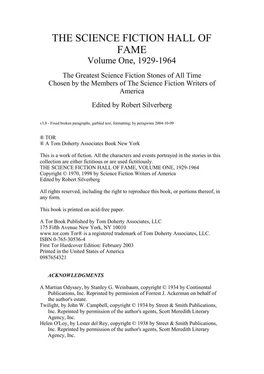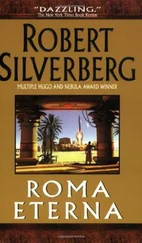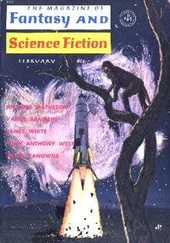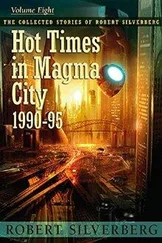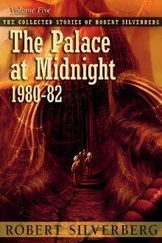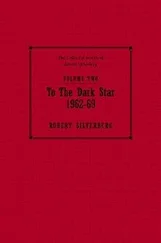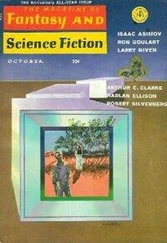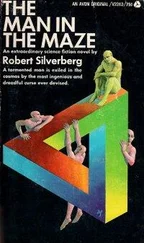"Oh, that?" Gaines answered the unspoken question as he slid back a panel door and ushered his guest through. "That's a wind break. If we didn't have some way of separating the air currents over the strips of different speeds, the wind would tear our clothes off on the hundred- mile-an-hour strip." He bent his head to Blekinsop's as he spoke, in order to cut through the rush of air against the road surfaces, the noise of the crowd, and the muted roar of the driving mechanism concealed beneath the moving strips. The combination of noises inhibited further conversation as they proceeded toward the middle of the roadway. After passing through three more wind screens located at the forty, sixty, and eighty-mile-an-hour strips, respectively, they finally reached the maximum-speed strip, the hundred-mile-an-hour strip, which made the round trip, San Diego to Reno and back, in twelve hours.
Blekinsop found himself on a walkway, twenty feet wide, facing another partition.
Immediately opposite him an illuminated show-window proclaimed: JAKE'S STEAK HOUSE No. 4 The Fastest Meal on the Fastest Road!
"To dine on the fly Makes the miles roll by!"
"Amazing!" said Mr. Blekinsop. "It would be like dining in a tram. Is this really a proper restaurant?"
"One of the best. Not fancy, but sound."
"Oh, I say, could we—"
Gaines smiled at him. "You'd like to try it, wouldn't you, sir?"
"I don't wish to interfere with your plans—"
"Quite all right. I'm hungry myself, and Stockton is a long hour away. Let's go in."
Gaines greeted the manageress as an old friend. "Hello, Mrs. McCoy. How are you tonight?"
"If it isn't the chief himself! It's a long time since we've had the pleasure of seeing your face." She led them to a booth somewhat detached from the crowd of dining commuters. "And will you and your friend be having dinner?"
"Yes, Mrs. McCoy. Suppose you order for us—but be sure it includes one of your steaks."
"Two inches thick—from a steer that died happy." She glided away, moving her fat frame with surprising grace.
With sophisticated foreknowledge of the chief engineer's needs, Mrs. McCoy had left a portable telephone at the table. Gaines plugged it into an accommodation jack at the side of the booth, and dialed a number. "Hello—Davidson? Dave, this is the chief.
I'm in Jake's Steak House No. 4 for supper. You can reach me by calling 10-L-6-6."
He replaced the handset, and Blekinsop inquired politely: "Is it necessary for you to be available at all times?"
"Not strictly necessary," Gaines told him, "but I feel safer when I am in touch.
Either Van Kleeck, or myself, should be where the senior engineer of the watch—
that's Davidson this shift—can get hold of us in a pinch. If it's a real emergency, I want to be there, naturally."
"What would constitute a real emergency?"
"Two things, principally. A power failure on the rotors would bring the road to a standstill, and possibly strand millions of people a hundred miles, or more, from their homes. If it happened during a rush hour, we would have to evacuate those millions from the road—not too easy to do."
"You say millions—as many as that?"
"Yes, indeed. There are twelve million people dependent on this roadway, living and working in the buildings adjacent to it, or within five miles of each side."
The Age of Power blends into the Age of Transportation almost imperceptibly, but two events stand out as landmarks in the change: The invention of the Sun-power screen, and the opening of the first moving road. The power resources of oil and coal of the United States had— save for a few sporadic outbreaks of common sense—been shamefully wasted in their development all through the first half of the twentieth century. Simultaneously, the automobile, from its humble start as a one- lunged horseless carriage, grew into a steel-bodied monster of over a hundred horsepower and capable of making more than a hundred miles an hour. They boiled over the countryside, like yeast in ferment. In the middle of the century it was estimated that there was a motor vehicle for every two persons in the United States.
They contained the seeds of their own destruction. Seventy million steel juggernauts, operated by imperfect human beings at high speed, are more destructive than war. In the same reference year the premiums paid for compulsory liability and property damage insurance by automobile owners exceeded in amount the sum paid the same year to purchase automobiles. Safe driving campaigns were chronic phenomena, but were mere pious attempts to put Humpty-Dumpty together again. It was not physically possible to drive safely in those crowded metropolises. Pedestrians were sardonically divided into two classes, the quick and the dead.
But a pedestrian could be defined as a man who had found a place to park his car.
The automobile made possible huge cities, then choked those same cities to death with their numbers. In 1900 Herbert George Wells pointed out that the saturation point in the size of a city might be mathematically predicted in terms of its transportation facilities. From a standpoint of speed alone the automobile made possible cities two hundred miles in diameter, but traffic congestion, and the inescapable, inherent danger of high-powered, individually operated vehicles canceled out the possibility.
Federal Highway No. 66 from Los Angeles to Chicago, "The Main Street of America," was transformed into a superhighway for motor vehicles, with an underspeed limit of sixty miles per hour. It was planned as a public works project to stimulate heavy industry; it had an unexpected by-product. The great cities of Chicago and St. Louis stretched out urban pseudopods toward each other, until they met near Bloomington, Illinois. The two parent cities actually shrank in population.
The city of San Francisco replaced its antiquated cable cars with moving stairways, powered with the Douglas-Martin Solar Reception Screens. The largest number of automobile licenses in history had been issued that calendar year, but the end of the automobile was in sight. The National Defense Act closed its era.
This act, one of the most bitterly debated ever to be brought out of committee, declared petroleum to be an essential and limited material of war. The army and navy had first call on all oil, above or below the ground, and seventy million civilian vehicles faced short and expensive rations.
Take the superhighways of the period, urban throughout their length. Add the mechanized streets of San Franciso's hills. Heat to boiling point with an imminent shortage of gasoline. Flavor with Yankee ingenuity. The first mechanized road was opened between Cincinnati and Cleveland.
It was, as one would expect, comparatively primitive in design. The fastest strip moved only thirty miles per hour, and was quite narrow, for no one had thought of the possibility of locating retail trade on the strips themselves. Nevertheless, it was a prototype of the social pattern which was to dominate the American scene within the next two decades —neither rural nor urban, but partaking equally of both, and based on rapid, safe, cheap, convenient transportation.
Factories—wide, low buildings whose roofs were covered with solar power screens of the same type that drove the road—lined the roadway on each side. Back of them and interspersed among them were commercial hotels, retail stores, theaters, apartment houses. Beyond this long, thin, narrow strip was the open countryside, where much of the population lived. Their homes dotted the hills, hung on the banks of creeks, and nestled between the farms. They worked in the "city," but lived in the
"country"—and the two were not ten minutes apart.
Mrs. McCoy served the chief and his guest in person. They checked their conversation at the sight of the magnificent steaks. Up and down the six-hundred-mile line, sector engineers of the watch were getting in their hourly reports from their subsector technicians. "Subsector One—check!" "Subsector Two—check!"
Читать дальше
